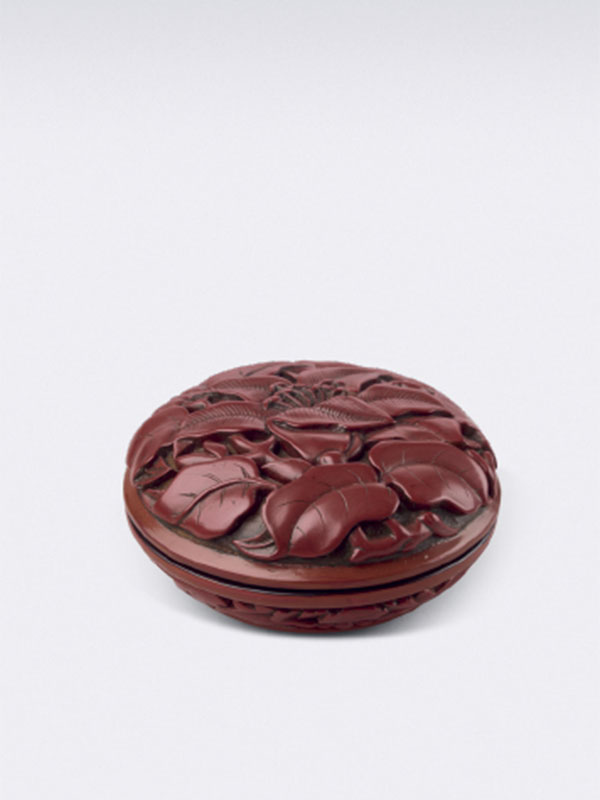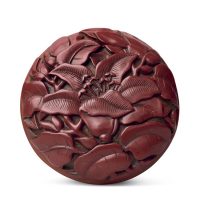Lacquer incense box
China, Ming dynasty, Yongle period, 1403 - 1425
A small lacquer box of circular form. The domed top is carved through a thick layer of red lacquer to the ochre ground and depicts a single, open hibiscus flower, surrounded by buds and folded leaves with well-rounded edges. A band of three peonies interspersed with leaves decorates the bottom section of the box against a background of ochre coloured lacquer, visible in some small areas. The interior and recessed base are lacquered black.
The competent, confident carving of decorative designs through a thick layer of red lacquer against an ochre ground, resulting in the kind of bold and at the same time elegant, well-balanced floral composition seen on this exquisite little box is very much a feature of early 15th century lacquer craftsmanship, and particularly that of the Yongle period. The edges of the design are smoothly rounded, making the box a delight to touch and hold. The flower design incorporates hibiscus (furong) and peony (shaoyao), both of which are popular wealth motifs in China.[1] The Japanese in particular greatly admired and collected Chinese lacquer during the Ming dynasty and it is thought that small boxes such as this, used for the storage of incense powder and known as kogo in Japanese, adorned the altars of the Shogun and Daimyo formal residences. A comparable incense box carved with very similar floral motifs is in the collection of the Tokugawa Art Museum in Japan.[2] Another similar box of almost identical proportions and dated to the Yongle period was formerly in the Lee Family Collection and is also carved with a single flower.[3]
Provenance:
Ben Janssens Oriental Art, September 2010
Private Collection, UK
1 Bjaaland Welch, P. Chinese Art: A Guide to Motifs and Visual Imagery, Tuttle Publishing, Hong Kong, 2008, p. 26 and 34
2 Karamono: Imported Lacquerwork – Chinese, Korean, and Ryukyuan (Okinawa), Selections from the Tokugawa Art Museum, Vol. II, no. 59, p.42
3 Lee King Tsi and Hu Shih Chang, Dragon and Phoenix: Chinese Lacquer Ware, The Lee Family Collection, Tokyo, The Museum of East Asian Art, Cologne, 1990, no. 47, p. 122-3
明/剔红玉兰花纹粉盒
此盒圆形,卧足,子母口,上下等分。其表面整体厚髹红漆,仅底足内髹黑漆。红漆部分雕玉兰花一朵,并以其为中心雕大量枝叶。雕工深入细致,打磨圆润。


